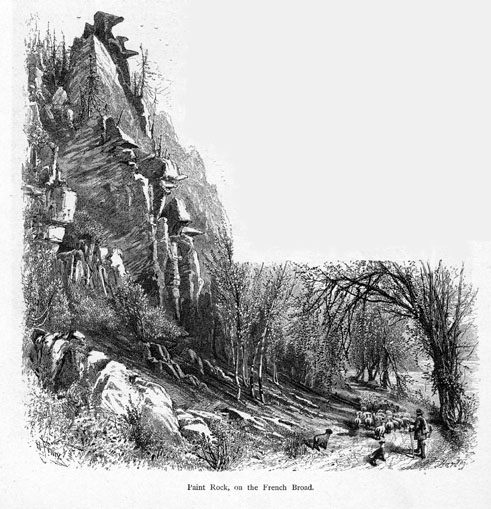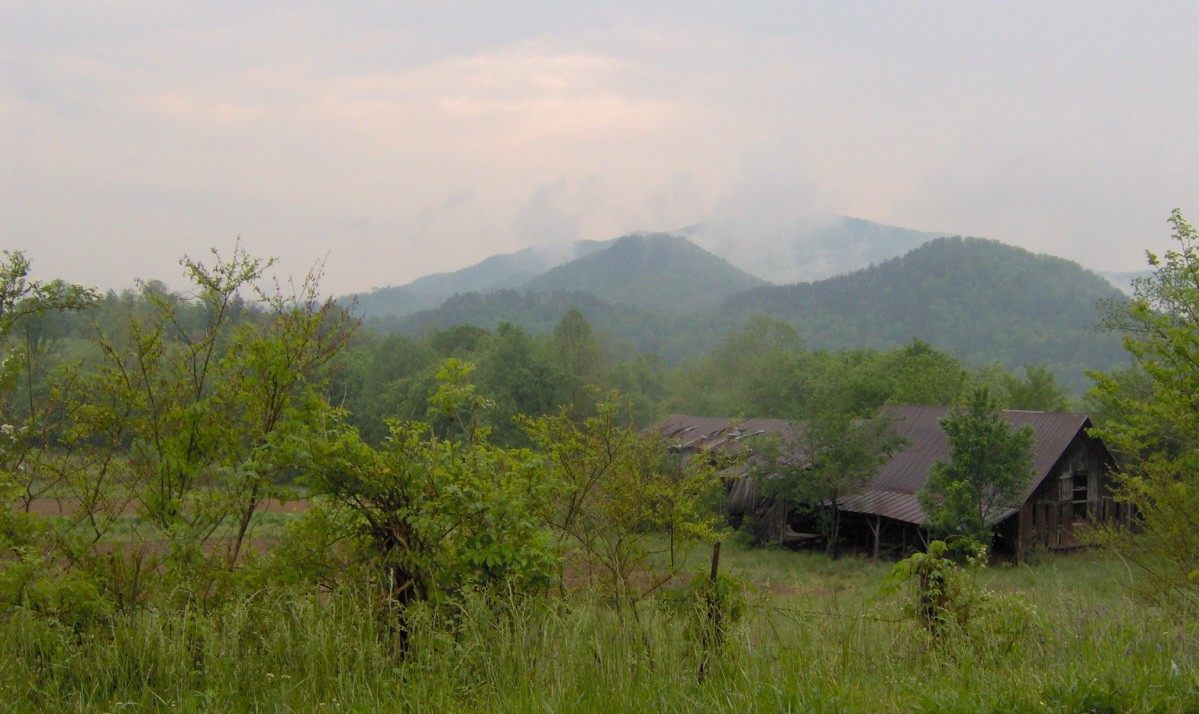The Great Appalachian Hog Drives

A drove of hogs nears Chicago as a train passes in the background in an illustration from the 1860s. (Photo: Courtesy of Wikimedia Commons.)
On a trip through the North Carolina mountains in 1878, Virginia newspaper editor James Cowardin found himself surrounded by thousands of pigs. “Hogs were before us and behind us, and both to the right and to the left of us,” Cowardin wrote. “There was whipping and shouting and twisting and turning” as the swineherds yelled, “Suey!” “Suey!” “Get out!” “Suey hogs!” “D—d devil take the swine!” Cowardin too cursed the pigs at first, but once he settled into the rhythm of the road, he began to daydream about following his “grunting friends” to their destination and enjoying a pig slaughter feast: “What luxury in spare ribs, backbone, and sausage we would have,” he fantasized, “not to mention pigs’ tails broiled on hot rocks!”
The flesh of Cowardin’s traveling companions, though, was destined for other stomachs. He had stumbled upon a seasonal movement of livestock that had been happening each winter for more than half a century. He was in the middle of a pig drive.
The swine had been fattened in eastern Tennessee, a fertile farming region with many pigs and few people. A couple of hundred miles away lay the plantations of the South, which didn’t raise much food. Planters preferred to grow cotton, sell it for cash, and buy pork to feed their slaves (or, after the Civil War, their sharecroppers and tenant farmers). The hog supply was in Tennessee, the demand in South Carolina and Georgia, and in between lay the Blue Ridge mountains. No navigable rivers or railroads connected the two, so there was only one way to move the hogs: on foot. The route followed the valley of French Broad River through the Smoky Mountains, passed through Asheville, North Carolina, and then descended the Blue Ridge escarpment into Spartanburg and Greenville, South Carolina.

Inns known as “wagon stands”—such as this one just north of Asheville, North Carolina—were spaced at ten-mile intervals along the drovers’ roads, giving hogs and their herders a place to sleep and eat before resuming the journey and walking another ten miles the next day. (Photo: Courtesy of Wikimedia Commons.)
Think of it: Pig drives, like cattle drives, only stranger. Who knew a pig could walk that far or would travel in the desired direction? Apparently, not many people. In 2006 a prominent archaeologist, a specialist in livestock, baldly insisted that pigs “cannot be driven.” The historical record suggests otherwise.
Before motorized trucks became common, nearly all livestock went to market on foot: cattle, horses, mules, sheep, goats, turkeys, ducks, and geese. (“That was the prettiest drive of anything they drove,” a Tennessee drover said of geese. “They’d just paddle along on them webbed feet.”) Hogs, though, ruled the road. Americans raised more pigs than any other type of animal, so naturally swine crowded out other beasts on the turnpikes. The best estimates suggest that in the antebellum South, five times as many hogs were driven as all other animals combined. In 1847 one tollgate in North Carolina recorded 692 sheep, 898 cattle, 1,317 horses, and 51,753 hogs.

Here a shepherd and his dog herd sheep along the French Broad River in North Carolina just south of the Tennessee border in 1873. (Photo: Courtesy of Wikimedia Commons.)
As the United States grew, traveling hordes of pigs crisscrossed the country in all directions. The farmers who rushed to settle the West after the Revolutionary War soon returned east with pigs to sell. Around 1800 some of the very first Corn Belt hogs were driven from Ohio farms to Baltimore slaughterhouses. Other hogs walked from Kentucky to Virginia, from the Nashville basin to Alabama, and from southern Illinois to Chicago.
By the 1840s and 1850s, a growing rail network mostly ended the era of long-distance driving, but the railroad builders were stymied by the Blue Ridge Mountains, which separated the hog-raising regions of Kentucky and Tennessee from the pork-eating slave South. A few farmers from the Bluegrass region of Kentucky—pig country before the horses took over—walked their hogs through the Cumberland Gap and all the way to Charleston, South Carolina, a distance of more than five hundred miles.

The Smoky Mountains rise above Del Rio, Tennessee. The town, formerly know as Big Creek, served as a gathering point for drovers before they herded their hogs into the mountains for the long journey South. (Photo: Brian Stansberry, Creative Commons Attribution-Share Alike 3.0)
Pig drives followed fairly standard protocols. The drover, on horseback, rode at the front of a herd that might range from a few hundred to 1,000 or more hogs. Following behind, on foot, were his employees, called drovers, usually one for every one hundred pigs. The drivers shouted, “Soo-eey,” “Su-boy,” or “Ho-o-o-yuh”—this last, according to one witness, was pronounced thusly: “The first syllable is like a prolonged wail, while the last syllable is hurled out with a snap and a thud, much like the exclamation one might make if suddenly hit in the solar plexus.”
This was not easy work. Whenever a roadside creek or pond appeared, the pigs flopped into the mud and commenced wallowing. The secret, one drover said, lay in not exerting too much control: “Never let a hog know he’s being driven. Just let him take his way, and keep him going in the right direction.” The start of the journey was especially difficult, for during that stage loud noises could send pigs stampeding back toward their home farms. One solution was to sew up their eyelids: temporarily blinded, the pigs clumped together and kept to the road by feel. At their destination, the stitch was clipped and their vision restored. (The young Abraham Lincoln, charged with driving a recalcitrant drove of hogs aboard a riverboat, pulled out a needle and thread and started sewing.) After a few days on the road, the hogs settled into a routine, and the biggest problem became beasts who couldn’t keep up. Lame pigs were traded to innkeepers for room and board.

Pigs on the drovers’ roads ranged from unimproved types–like this one from a 1877 farming manual–to breeds such as the Poland China that had been specially developed to walk long distances. (Photo: Courtesy of Wikimedia Commons.)
Cows, sheep, and goats have been driven great distances for millennia because they move well in herds and require only grass or other greenery along the way. Driving pigs on such long journeys has been rare historically because it is more difficult: the animals not only needed shade and tended to scatter but also required provisions en route. The swineherds of the Roman Empire were among the few to take on such challenges: tens of thousands of hogs walked well over a hundred miles to Rome from the forested regions of Campania, Samnium, and Lucania. We don’t know many details of their journey, but we do know that they lost weight.
Weight loss on the road was known as “drift,” and in the United States an infrastructure grew up to ensure it didn’t happen. Because pigs could walk about ten miles a day, inns—often known as wagon stands—sprang up at ten-mile intervals along the roads, offering drovers and their pigs food and a place to sleep. At the taverns, the hogs were herded into corrals and given corn, usually eight bushels per one hundred hogs. One traveler described watching a drove of 1,000 hogs eat their evening meal: “The music made by this large number of hogs, in eating corn on a frosty night, I will never forget.”

Men drive hogs down an Appalachian road in this 1857 illustration from Harper’s New Monthly Magazine. Hogs that went lame on the journey, like the one in the foreground, were traded to tavern owners to offset the cost of lodging. (Photo: Courtesy of Wikimedia Commons.)
Because droving was a decentralized trade, it’s impossible to know its full scale. It is clear, however, that hog drives were at least as significant as the far more famous cattle drives. The largest cattle drives, from Texas to Kansas, involved as many as 600,000 cattle a year, but they lasted just fifteen years or so. Hog droving, by comparison, involved hundreds of thou- sands of animals during peak years and on some routes lasted nearly a century. From Kentucky alone, as many as 100,000 hogs per year were driven east to Richmond, Baltimore, and Philadelphia. In 1855 more than 83,000 hogs walked along a little-known route through Mount Airy, North Carolina. And there were many other routes: through Asheville along the French Broad River, from the Nashville basin along the Natchez Trace into Alabama, through Knoxville into Georgia, and out of Kentucky through the Cumberland Gap or along the Kanawha River. The route through the Cumberland Gap in Kentucky, known as the Wilderness Road in the years immediately after Daniel Boone blazed it, later came to be known as the “Kaintuck Hog Road” after its most frequent traveler. Once the drovers had crossed the mountains, they fanned out to sell their hogs, either at individual plantations or at the local slaughterhouses that served the rural market.

Pig statues in downtown Asheville commemorate the great nineteenth-century hog drives. Notches cut into a pig’s ear–shown here on the adult pig–served to identity its owner, much like a cattle brand. The inclusion of the piglet statue is historically inaccurate: the hogs were being driven to slaughter, so all piglets would have stayed behind on the farm to grow before making the journey the following year. (Photo: Mark Essig.)
Hog droving, as the practice was known, formed an essential link in the global economy. In peak years as many as 150,000 hogs made the journey on this single turnpike, and many other mountain routes also carried pigs from upland farms to the Deep South. The pork fed the slaves, who raised the cotton, which supplied textile mills in New England and Great Britain, which made the fabric that clothed the world. And it all depended on a few men herding hogs through the mountains of North Carolina.
This is an excerpt from Lesser Beasts: A Snout-to-Tail History of the Humble Pig. For more info, go here.



Follow us on Twitter to get the latest on the world's hidden wonders.
Like us on Facebook to get the latest on the world's hidden wonders.
Follow us on Twitter Like us on Facebook